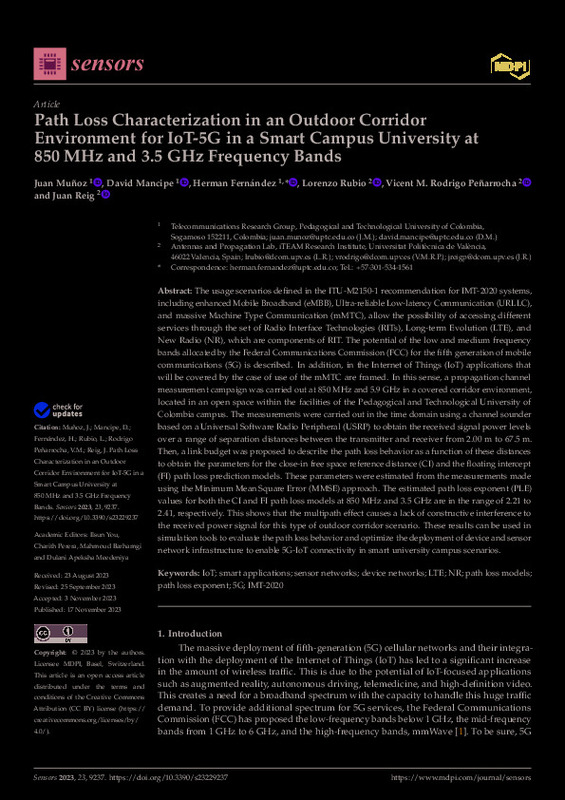JavaScript is disabled for your browser. Some features of this site may not work without it.
Buscar en RiuNet
Listar
Mi cuenta
Estadísticas
Ayuda RiuNet
Admin. UPV
Path Loss Characterization in an Outdoor Corridor Environment for IoT-5G in a Smart Campus University at 850 MHz and 3.5 GHz Frequency Bands
Mostrar el registro sencillo del ítem
Ficheros en el ítem
| dc.contributor.author | Muñoz, Juan
|
es_ES |
| dc.contributor.author | Mancipe, David
|
es_ES |
| dc.contributor.author | Fernández, Herman
|
es_ES |
| dc.contributor.author | Rubio Arjona, Lorenzo
|
es_ES |
| dc.contributor.author | Rodrigo Peñarrocha, Vicent Miquel
|
es_ES |
| dc.contributor.author | Reig, Juan
|
es_ES |
| dc.date.accessioned | 2024-03-04T19:02:22Z | |
| dc.date.available | 2024-03-04T19:02:22Z | |
| dc.date.issued | 2023-11 | es_ES |
| dc.identifier.uri | http://hdl.handle.net/10251/202912 | |
| dc.description.abstract | [EN] The usage scenarios defined in the ITU-M2150-1 recommendation for IMT-2020 systems, including enhanced Mobile Broadband (eMBB), Ultra-reliable Low-latency Communication (URLLC), and massive Machine Type Communication (mMTC), allow the possibility of accessing different services through the set of Radio Interface Technologies (RITs), Long-term Evolution (LTE), and New Radio (NR), which are components of RIT. The potential of the low and medium frequency bands allocated by the Federal Communications Commission (FCC) for the fifth generation of mobile communications (5G) is described. In addition, in the Internet of Things (IoT) applications that will be covered by the case of use of the mMTC are framed. In this sense, a propagation channel measurement campaign was carried out at 850 MHz and 5.9 GHz in a covered corridor environment, located in an open space within the facilities of the Pedagogical and Technological University of Colombia campus. The measurements were carried out in the time domain using a channel sounder based on a Universal Software Radio Peripheral (USRP) to obtain the received signal power levels over a range of separation distances between the transmitter and receiver from 2.00 m to 67.5 m. Then, a link budget was proposed to describe the path loss behavior as a function of these distances to obtain the parameters for the close-in free space reference distance (CI) and the floating intercept (FI) path loss prediction models. These parameters were estimated from the measurements made using the Minimum Mean Square Error (MMSE) approach. The estimated path loss exponent (PLE) values for both the CI and FI path loss models at 850 MHz and 3.5 GHz are in the range of 2.21 to 2.41, respectively. This shows that the multipath effect causes a lack of constructive interference to the received power signal for this type of outdoor corridor scenario. These results can be used in simulation tools to evaluate the path loss behavior and optimize the deployment of device and sensor network infrastructure to enable 5G-IoT connectivity in smart university campus scenarios. | es_ES |
| dc.description.sponsorship | This work has been funded in part by the MCIN/AEI/10.13039/501100011033/ through the I+D+i Project under Grant PID2020-119173RB-C21, by the Pedagogical and Technological University of Colombia (Project Number SGI 3159) and by the Bicentennial Doctoral Excellence Scholarship Minciencias-Program (Contract BPIN 2019000100041). | es_ES |
| dc.language | Inglés | es_ES |
| dc.publisher | MDPI AG | es_ES |
| dc.relation.ispartof | Sensors | es_ES |
| dc.rights | Reconocimiento (by) | es_ES |
| dc.subject | IoT | es_ES |
| dc.subject | Smart applications | es_ES |
| dc.subject | Sensor networks | es_ES |
| dc.subject | Device networks | es_ES |
| dc.subject | LTE | es_ES |
| dc.subject | NR | es_ES |
| dc.subject | Path loss models | es_ES |
| dc.subject | Path loss exponent | es_ES |
| dc.subject | 5G | es_ES |
| dc.subject | IMT-2020 | es_ES |
| dc.subject.classification | TEORÍA DE LA SEÑAL Y COMUNICACIONES | es_ES |
| dc.title | Path Loss Characterization in an Outdoor Corridor Environment for IoT-5G in a Smart Campus University at 850 MHz and 3.5 GHz Frequency Bands | es_ES |
| dc.type | Artículo | es_ES |
| dc.identifier.doi | 10.3390/s23229237 | es_ES |
| dc.relation.projectID | info:eu-repo/grantAgreement/AEI/Plan Estatal de Investigación Científica y Técnica y de Innovación 2017-2020/PID2020-119173RB-C21/ES/TECNICAS DE MEDIDA Y MODELOS AVANZADOS DE CANAL PARA LA DEFINICION DE LOS FUTUROS SISTEMAS 6G (A6GMODEL-UPV)/ | es_ES |
| dc.relation.projectID | info:eu-repo/grantAgreement/COLCIENCIAS//BPIN 2019000100041/ | es_ES |
| dc.relation.projectID | info:eu-repo/grantAgreement/UPTC//SGI 3159/ | es_ES |
| dc.rights.accessRights | Abierto | es_ES |
| dc.contributor.affiliation | Universitat Politècnica de València. Escuela Técnica Superior de Ingenieros de Telecomunicación - Escola Tècnica Superior d'Enginyers de Telecomunicació | es_ES |
| dc.description.bibliographicCitation | Muñoz, J.; Mancipe, D.; Fernández, H.; Rubio Arjona, L.; Rodrigo Peñarrocha, VM.; Reig, J. (2023). Path Loss Characterization in an Outdoor Corridor Environment for IoT-5G in a Smart Campus University at 850 MHz and 3.5 GHz Frequency Bands. Sensors. 23(22). https://doi.org/10.3390/s23229237 | es_ES |
| dc.description.accrualMethod | S | es_ES |
| dc.relation.publisherversion | https://doi.org/10.3390/s23229237 | es_ES |
| dc.type.version | info:eu-repo/semantics/publishedVersion | es_ES |
| dc.description.volume | 23 | es_ES |
| dc.description.issue | 22 | es_ES |
| dc.identifier.eissn | 1424-8220 | es_ES |
| dc.identifier.pmid | 38005623 | es_ES |
| dc.identifier.pmcid | PMC10675808 | es_ES |
| dc.relation.pasarela | S\507425 | es_ES |
| dc.contributor.funder | Agencia Estatal de Investigación | es_ES |
| dc.contributor.funder | Universidad Pedagógica y Tecnológica de Colombia | es_ES |
| dc.contributor.funder | Departamento Administrativo de Ciencia, Tecnología e Innovación, Colombia | es_ES |








